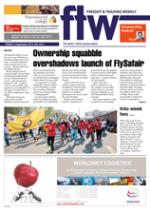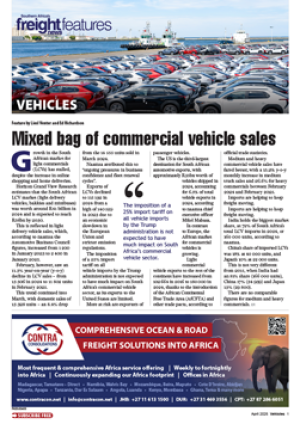The launch by Safair of a new
low-cost carrier, FlySafair, on
the Johannesburg-Cape Town
route – currently dominated
by the national carrier and
Comair – will add options for
the freight industry.
But according to parent
company Safair’s vice-president
commercial, Neville Desselss,
the take-off date for the new
service – to be operated by a
Boeing 737-400 – is still up
in the air, and available cargo
capacity is as yet undecided. “At
this stage,” he told FTW, “we
are still investigating the cargo
option.”
While the industry has
welcomed the possible
additional capacity along with
all the cost-related benefits
of competition, the launch
of the new service has been
overshadowed by an intriguing
debate about who-owns-what.
An argument is currently
taking place between airlines
Comair and Safair, in which
the ownership of FlySafair –
and, in turn, of parent Safair
– is being disputed.
Comair’s point is that the
airline ownership exceeds the
permissible 25% stockholding
allowed to be held by a foreign
owner, and it should therefore
not have been granted a licence
by the SA Air Service Licensing
Council.
Comair CEO Erik Venter
said the company had raised
its objections to the licensing
council in July when Safair
applied for a scheduled
passenger service licence under
the name FlySafair.
But the council rejected
Comair’s complaint and
granted the licence for FlySafair
to operate up to ten daily flights
between Johannesburg and
Cape Town – using two Boeing
737-400 aircraft.
Safair CEO, Dave
Andrew, said that 75 % of
the company was controlled
by three directors, himself,
chairman Hugh Flynn, and
chief financial officer Elmar
Conradie.
But Comair intends to make
an objection to the licensing
council over the granting of
the licence and, if necessary,
apply for an interdict to stop
FlySafair from taking off.
It has tabled two objections
to the licensing council. The
objections are based on Flynn’s
dual citizenship. According
to Venter and Comair’s head
of regulatory affairs, Kim
Gorringe, Flynn resides
permanently in Ireland and
visits SA occasionally. In
addition, Gorringe said Safair
was actually a front and wholly
owned by the ALS Aviation
Group.
Now this is where everything
becomes a bit cloudy. That
who-owns-what question is not
easy to answer – possibly apart
from the fact that Safair said it
owned FlySafair.
But who owns the Safair
group?
FTW did some extensive
digging, and came up with
the following history of Safair
from 2007.
At that time, it was owned
by the Imperial Group. But in
late 2007 Imperial decided
to dispose of all its aviationrelated
businesses.
Included in these were
Safair Lease Finance and
Safair Operations, which were
sold along with
other assets of
the Imperial
Aviation
division to
“various
subsidiaries of
Aergo Capital
Limited, an
aircraft leasing
company based
in Ireland”,
according to an
official notice at
the time from
Imperial.
Hubert
Brody, CEO
of Imperial
Holdings, now confirmed
to FTW that his group had
indeed sold these to Aergro,
lock, stock but not quite barrel.
What remained were a
fleet of nine Hercules aircraft,
which were to be leased by
Aergo for a maximum period
of five years, and three MD 80
series aircraft and two Boeing
737-200 aircraft, which were
running out their existing
lease contracts and were to be
disposed of thereafter.
The deal for the acquisition
of the SA aircraft leasing and
operating company Safair was
stated by Aergo as finalised in
December 2008.
Then in September 2010,
the Irish Times reported that
Aergo Capital had sold its
interest in Johannesburgbased
subsidiary Safair to
Dublin-based listed company,
ASL Aviation.
The deal involved Aergo
selling its interest in Safair
Operations, Safair Lease
Finance and three ATR72-
500 aircraft. The deal was
concluded by November.
In talking about whoowned-
what earlier, we used
the terms “cloudy” to describe
the difficulty in finding what
to believe. But now, it’s a
positive thunderstorm.
ASL’s web
page, talking
about the
history of the
group, came
up with a
rather startling
statement.
“In 2007,” it
said, “Imperial
disposed of all
its aviationrelated
businesses
– which were
acquired by
CMB and 3P
Airfreighters.”
Now
the ASL group has two
shareholders – Compagnie
Maritime Belge (CMB),
a major Belgian shipping
company based in Antwerp,
with a 51% shareholding; and
3P Air Freighters, an aircraft
leasing company incorporated
in Dublin, with 49%.
But it then said –
“Acquisition of the Safair
Group was finalised in late
2010, which includes the
leasing and airline operations,
based in SA” – which at least
complies with the date of that
supposed acquisition from
Aergro.
And it certainly clearly
states that it still owns Safair.
ASL also lists Safair and
its activities for the year in its
2012 annual report – so
it seems to have no doubts
about the fact that it owns
Safair.
But Andrew said Safair was
not a subsidiary of ASL, but
rather an associate company.
Although it is not stated
in any of the Aergro or ASL
documentation available to
FTW, it would seem that
Andrew’s case is that the three
South Africans acquired their
75% stakeholding after the
takeover of Safair by Irelandbased
Aergo Capital in 2008
from Imperial Holdings. “I
believe that it is….pertinent
to reiterate that Safair has
had a 75% South African
shareholding since 2009,” said
Andrew. It would then appear
that Aergo sold its remaining
25% stake to ASL in 2010.
That is possibly why
Comair’s other objection is
about Flynn’s residence.
In Section 16 (4) (c) (ii)
and (d) of the Air Services
Licensing Act No 115 of 1990,
any applicant for a Type S1
To Class 1 Air Service Licence
needs to have at least 75% of
its voting rights held by SA
residents.
The latest arguments
venture off into the
implications of “dual
citizenship” and the frequency
of Flynn’s visits to SA.
But it’s all too murky and
contradictory for FTW to
reach a conclusion. Rather
we and our readers must wait
till the licensing council, or
possibly a court, comes up
with a decision on: Who owns
what, and who lives where?
INSERT & CAPTION
Comair raised its
objections to the
licensing council
in July when Safair
applied for a
scheduled passenger
service licence under
the name FlySafair.
– Erik Venter

